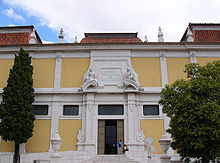National Museum of Ancient Art
 |
|
| Established | 1884 |
|---|---|
| Location | Lisbon, Portugal |
| Type | Art Museum |
| Visitors | 80.591 (1st half of 2015) |
| Director | António Filipe Pimentel |
| Website | www.museudearteantiga.pt/english |
The Museu Nacional de Arte Antiga (Portuguese pronunciation: [muˈzew nɐsiuˈnaɫ dɨ ˈaɾtɐ̃ˈtiɡɐ]) is an art museum in Lisbon, Portugal.
The museum is also known as MNAA (in English, National Museum of Ancient Art) and as the Museu das Janelas Verdes ("Museum of the Green Windows") for its location in the Rua das Janelas Verdes ("Street of the Green Windows"). It occupies the Palácio de Alvor-Pombal, a former palace of the Count of Alvor, later purchased by the Marquess of Pombal.
The Museum has its roots in the 1833 abolition of religious orders and confiscation of the monasteries in Portugal, which brought a trove of religious art and ornaments into the public sphere. At the instigation of the liberal politician Passos Manuel, the Academia de Bellas Artes ("Academy of Fine Arts") was founded in 1836, and established its headquarters at the former monastery of São Francisco da Cidade (near the Chiado, in Lisbon). Although primarily dedicated to nurturing new artists, that same year, the Academia founded the Galeria Nacional de Pintura ("National Gallery of Painting") on the lower levels of the same building, as a subsidiary division to select, care for and display some of the better pieces of the expropriated monastic art then in government storage. An Academia panel selected some 540 paintings for the Galeria. Predictably, most of these were religious-oriented pieces of Portuguese origin.
In the chaos and aftermath of the Portuguese Liberal Wars, some of the private art collections of ruined noble families were expropriated or found their way on to the market. Of particular significance was the painting collection of the disgraced former queen, the late Carlota Joaquina, which was acquired by the Portuguese government and given to the Academia in 1859. The former king Ferdinand II of Portugal, a connoisseur of fine arts, took an interest in the budding organization, secured its royal sponsorship (it was renamed Academia Real de Belas Artes in 1862) and, in 1865-67, Ferdinand II made a series of substantial cash donations, giving the Galeria an independent acquisition budget, enabling it to purchase pieces on the art market.
...
Wikipedia
